MXA RACE TEST: THE REAL TEST OF THE 2021 KAWASAKI KX450X CROSS-COUNTRY
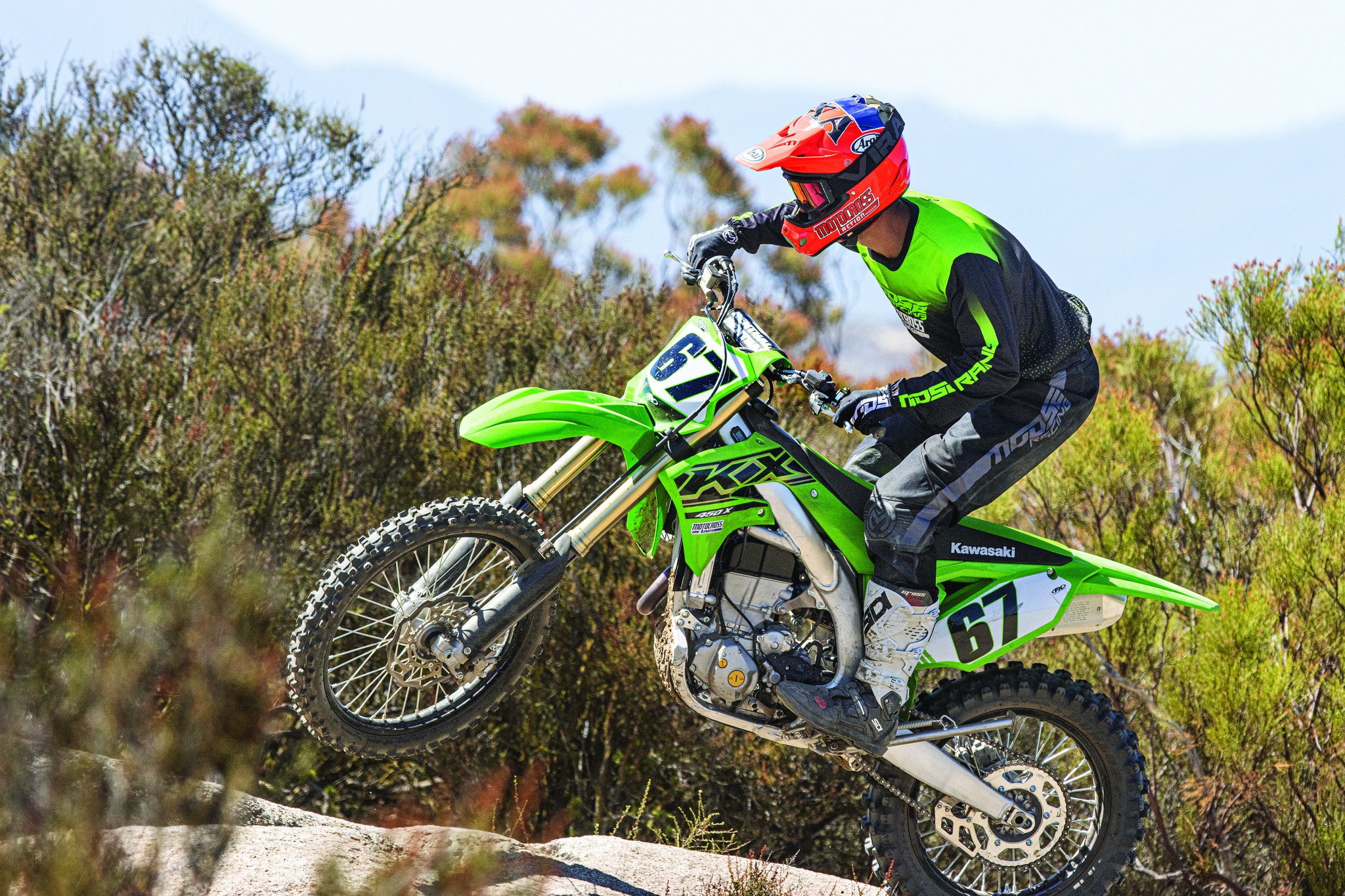
Q: FIRST AND FOREMOST, WHAT MAKES THE 2021 KAWASAKI KX450X DIFFERENT FROM THE 2021 KX450?
A: The KX450X cross-country model is just a KX450 in modest disguise. Here’s a list of the differences:
(1) 18-inch rear wheel. Instead of the standard 19-inch motocross rear wheel, the KX450X has the smaller-diameter 18-inch rim.
(2) Suspension. The 49mm Showa coil-spring fork and Uni-Trak rear shock suspension components are the same as the motocross versions, but with softer settings.
(3) Front brake pads. The KX450X comes with off-road-specific front brake pads to further differentiate this model from the motocrosser.
(4) Rear brake rotor. Interestingly enough, the KX450X comes with a 240mm rear brake rotor, while the KX450 still comes with the ultra-grabby 250mm rotor that MXA hates.
(5) Sprocket. The 2021 KX450 motocross model comes with a 50-tooth rear sprocket. To give the KX450X a little more pep in its step, help in slow sections of trail, and create tighter gear ratios, it has a 51-tooth rear sprocket.
(6) Tires. Dunlop’s AT-81 tires have off-road-specific rubber durometer settings and tread patterns. Plus, they have better resistance to pinch flats when riding over rocks and roots. But, they aren’t the first choice for motocross tracks.
(7) Protection. To protect against debris while out on the trail, the bike has a minimal skid plate, engine guards and a rear brake rotor guard.
(8) Kickstand. Without the kickstand, it’s almost impossible for the untrained eye to detect that this is an off-road model. The kickstand is ultra convenient any time you’re not in motion.
(9) Retail price. The 2021 KX450X retails for $9599, which is $200 more than the motocross version.
Q: DID THE KX450X GET THE SAME UPDATES AS THE MOTOCROSS VERSION?
A: Yes. The 2021 Kawasaki KX450X received the same three updates that came on the 2021 KX450. Here’s the update list:
(1) Clutch. From 2020 to 2021, the clutch’s total diameter was increased by 7mm to improve oil flow through the clutch mechanism. The judder spring was replaced by a full-sized eighth plate, and the five separate coil springs were replaced by a Belleville washer-style spring to create a stronger yet easier clutch engagement. Additionally, the fiber plates have three different types of friction materials. Now, there are different part numbers for the first fiber plate, the middle six fiber plates and the outer fiber plate. Lastly, the friction pads on the fiber plates are segmented at angles.
(2) Handlebars. Finally, finally, finally. The standard 7/8-inch handlebars were swapped out for Renthal’s 839-bend FatBars. Although it’s easy to think that the large-diameter 1-1/8-inch handlebars would equate to a more rigid feeling at the hands, the opposite is true. Standard 7/8-inch bars require a crossbar brace on the handlebars to make them strong. The crossbar brace hinders flex and actually creates a more rigid feel at the rider’s hands.
(3) Piston skirt. The piston skirt is coated with a new dry film lubricant to reduce friction between the piston and cylinder at low rpm. We can’t feel this on the track, but it’s nice to see Kawasaki making internal engine upgrades, too.
Q: HOW DIFFERENT IS THE SHOWA SUSPENSION FOR THE CROSS-COUNTRY BIKE?
A: It’s softer, much softer. The forks have a lighter 4.8 N/mm spring rate when compared to the 5.0 N/mm springs on the motocross version. The shock also has a softer 52 N/mm shock spring when compared to the 54 N/mm shock spring on the KX450. Additionally, the damping in the shim stack for both the forks and the shock has been adjusted to a lighter setting that moves easier and allows oil to flow through the valving with less effort. When compared to the KX450, the softer spring rate causes the bike to ride lower in the stroke, and the softer valving allows the suspension to compress easier. These settings were made for trails, not jumps.
Q: HOW DOES THE KX450X HANDLE?
A: Think sofa. The 5.0 N/mm forks on the KX450 motocross model are already way too soft, so you can easily imagine what the KX450X’s 4.8 N/mm spring rate and softer damping feel like. They are plush, especially when mated with the taller sidewall of the 18-inch-rear tire. It’s plush over rocks, logs, rain ruts and on tight woodsy trails. Surprisingly, we had a few test riders, those who were lighter or slower, who appreciated the softer setting on a motocross track.
The 1-inch-smaller rim allows for a tire with taller side walls and more rubber. The extra rubber helps improve traction by flexing more and creating a large contact patch on the ground. This helps off-road riders (and even motocross riders) in slippery conditions. More important, the extra rubber in the tall side walls allows the tire to flex more than a standard 19-inch wheel, acting like a secondary suspension system that soaks up more bumps to give the rider an even plusher feeling.
The KX450X comes with a 120/90-18 aspect-ratio rear tire. The first number (120) stands for the tire width in millimeters. The second number (90) represents the height of the tire as a percentage of the width. Thus, the height is not 90mm but 90 percent of 120mm, which would be 108mm. The third number (18) stands for the diameter of the rim in inches.
Besides the soft nature of the suspension and 18-inch rear wheel, the Kawasaki KX450X has the same nimble handling characteristics as the KX450. It’s easy to navigate into ruts on the motocross track and to go around trees in the woods.

Q: HOW DOES THE KX450X RUN?
A: A lot like a KX450. Why wouldn’t it? It has the same exact engine as the motocross version. MXA’s opinion on the KX450X powerband is a lot like our opinion on the KX450’s powerband; it’s friendly. The connection between the throttle and rear wheel is instantaneous, and the power, surprisingly, has a little too much punch off the bottom for tight single-track trails and slick conditions; however, after the responsive initial crack of the throttle, the power is smooth all the way through the rpm range without any big surges in power. We liked the 13/51 gearing as well.
Like the motocross version, the cross-country KX450X comes with three different couplers to adjust the power characteristics. It comes stock with the mellow black coupler installed to make the engine easier to ride. The black coupler softens the engine by 1 to 2 horsepower from 6000 rpm all the way to 11,500 rpm. It also comes with the stock KX450’s green coupler and optional white aggressive coupler.
Because Kawasaki left the engine alone and only changed exterior parts to turn the KX450 into the KX450F cross-country bike, they didn’t do anything special to the maps besides making the black mellow coupler the OEM map. If they had added a wide-ratio gear box, we would’ve seen some updates to the mapping.
Q: IS THE NEW 2021 CLUTCH ANY BETTER?
A: Yes. Although Kawasaki earned kudos in 2020 for adding hydraulic actuation to the clutch, the clutch itself was riddled with issues. The only difference between a hydraulic clutch and cable clutch is that the push rod, which separates the clutch plates, is engaged by hydraulic fluid and not a cable-and-cam system. That’s why some tech bulletins say “hydraulically actuated clutch” instead of “hydraulic clutch,” because the clutch internals are the same whether the push rod moves by cable or fluid.
The 2020 clutch overheated easily. It wore out fiber plates fast and we even broke them inside of our test bikes. The clutch lever was also stiff to pull in. With coil springs, pulling in the clutch gets stiffer as you get farther into the springs’ compression. Paradoxically, the new “coned disk” Belleville washer spring works the opposite way. It starts out at its stiffest point and gets easier to squeeze as the Belleville washer flattens out when you pull it in.
For off-road riding, and even motocross, the 2021 KX450 clutch, which is also found on the KX450X, is a big improvement over the 2020 KX450 hydraulically actuated clutch. The larger diameter of the system allows more oil to flow through the clutch, while the angled friction pads sling oil out of the clutch easier. More oil flow in the clutch helps to keep temperatures down and performance up. Plus, the Belleville washer makes it easier to separate the clutch plates, which creates less fatigue on the trail, especially when riding in the tight and technical stuff.
Q: HOW DOES THE KX450X REAR BRAKE DIFFER FROM THE KX450 REAR?
A: The most important difference is that it works better than the KX450 rear brake. Why? We’ve been complaining about the 250mm rotor on the KX450 motocross version since it was introduced in 2020. The 250mm KX450 rotor is too large, too grabby and too touchy to modulate. It is the largest rear rotor on any motocross model (a full 30mm larger in diameter than a KTM rear rotor); however, we were happy and confused when we saw the 2021 KX450X and KX250 have smaller 240mm rear brake rotors. It is strange that Kawasaki would fix its rear brake faux pas on the off-road model and the little-brother KX250 but not on its flagship KX450 bike. Oh well, at least we got to enjoy the smaller rear rotor on the KX450X.
Q: HOW MUCH DOES IT WEIGH?
A: The term “lightweight” doesn’t only pertain to factory Supercross racers, and it’s not a cheesy gimmick. Weight is not the friend of any high-performance vehicle. Unless you flunked basic physics in the 10th grade, you understand that a lighter motorcycle is not only easier to pick up, it is also easier to race. A heavy bike places more of a burden on the components that have to absorb the added inertia under acceleration, braking and bumps.
Without fuel, the KX450X weighs 235.8 pounds. KTM haters might not want to read this, but that is substantially heavier than its prime competitor—the KTM 450XC-F.
Q: IS THE KX450X A MOTOCROSS OR OFF-ROAD BIKE?
A: It’s somewhere in between. Without a bigger fuel tank, six-speed wide-ratio transmission, full-size skid plate or hand guards, it is hard to take the KX450X seriously as an off-roader. You can’t do any genuine off-roading on it without buying a bigger gas tank, and if you ride in super tight and technical trails or wide-open fast stuff, you’ll wish you had a more versatile six-speed transmission. When we decided to test it, our goal was to see how it would work for the rider who likes to ride trails one weekend and the track the next.
It is a compromise bike. It’s too soft for most motocrossers and not well-enough equipped for open country.

Q: WHAT DID WE HATE?
A: The hate list.
(1) Bar mounts. Kawasaki’s rubber-isolated handlebar mounts are frustrating. Very frustrating. We don’t like riding straight while our handlebars are turned to the side, and we don’t like pulling our front end apart to straighten them, either.
(2) Fuel tank. How can we do any real off-road riding if we are worried about running out of gas? If it’s advertised as a cross-country bike, we would like to be able to go further than a stock KX450 would take us.
(3) Kickstand. The concept is fine, but it falls down off jumps. No, we didn’t crash or feel it hit the ground. But, bystanders told us that it was pumping up and down like a Saudi oil well on every lap. We took it off.
(4) Muffler. How long does this thing really need to be?
(5) Air box. We needed 8mm and 10mm T-handles to get to the air filter, and that’s at least one size too many.
(6) Seat bolts. The backing plates behind the seat bolts fell out every time we removed the seat.
(7) Fork guards. If you’re racing and getting roosted by rocks, the cheap plastic on the Kawasaki fork guards will develop holes long before any other brand.
(8) Chain rollers. Chains are very important, and therefore so are chain rollers. Keep an eye on your lower chain roller, and once it wears out, replace all of the stock chain guide accessories with a TM Designworks Slide-n-Guide kit.
(9) Clutch plates. Purchasing and installing clutch plates is much more complicated now.
(10) Shock preload ring. Nothing is more defeating than chewing up the plastic on your shock’s preload ring when setting the sag on your brand-new KX450X. We already hate this piece on KTMs, and now Kawasaki has adopted it.
Q: WHAT DID WE LIKE?
A: The like list:
(1) Concept. Kawasaki has been ignoring a large segment of riders for the last 11 years. We appreciate the extra effort and investment it took for Kawasaki to get back into the off-road game.
(2) Handling. The KX450X is nimble and predictable.
(3) Clutch. The hydraulic actuation and new Belleville washer spring contribute to a clutch that is easier to pull in and more durable.
(4) Handlebars. Thankfully, Kawasaki caught up with the 1980 oversized-handlebar movement.
(5) Rear brake. Glad to see the 240mm rotor. It’s still powerful but less touchy than the larger KX450 one.
(6) Adjustability. The handlebars can be moved forward or backward into four different positions, and the footpegs can be lowered 5mm for taller or shorter riders.
(7) Protection. We’re glad to see a rudimentary skid plate and water-pump guard, but real off-road riding requires double this level of protection.
(8) Money. Kawasaki has always been known for its strong contingency program. Kawasaki offers racer rewards for over 485 local, regional and national racing events. There is $5.4 million available for Supercross and motocross, and there is $2 million up for grabs in off-road racing.

Q: WHAT DO WE REALLY THINK?
A: We’re thrilled that the 2021 Kawasaki KX450X brings Team Green back into the cross-country motorcycle game to compete with Yamaha, Honda, KTM and Husky. If you’re looking for an off-road bike that you can ride motocross tracks on, the KX450X’s suspension will be too soft. And if you’re looking for a motocross-capable bike that you can take on serious off-road rides, you won’t get very far away from your truck before you have to turn around or risk running out of gas on the KX450X.
MXA’S 2021 KAWASAKI KX450X SETUP SPECS
This is how we set up our 2021 Kawasaki KX450X for racing. We offer this as a guide to help you find your own sweet spot.
SHOWA SPRING FORK SETTINGS
For hardcore racing, we recommend this fork setup for an average rider on the 2021 Kawasaki KX450X (stock settings are in parentheses):
Spring rate: 4.8 N/mm
Compression: 8 clicks out (10 clicks out)
Rebound: 6 clicks out (8 clicks out)
Fork-leg height: First line (Second line)
Notes: The KX450X cross-country forks are soft. To stiffen them up, we dropped the forks down one line, slowed down the rebound, and went in on the compression to restrict oil flow at the valving to create a firmer feel.
SHOWA SHOCK SETTINGS
For hardcore racing, we recommend this shock setup for an average rider on the 2021 Kawasaki KX450X (stock settings are in parentheses):
Spring rate: 52 N/mm
Race sag: 105mm
Hi-compression: 9 clicks out (12 clicks out)
Lo-compression: 1 1/2 turns out (2 turns out)
Rebound: 7 clicks out (9 clicks out)
Notes: As with the forks, our test riders wanted more hold up in the shock. We slowed down the shock on high- and low-speed compression and closed off the rebound to 7 clicks out to firm up the rear end.



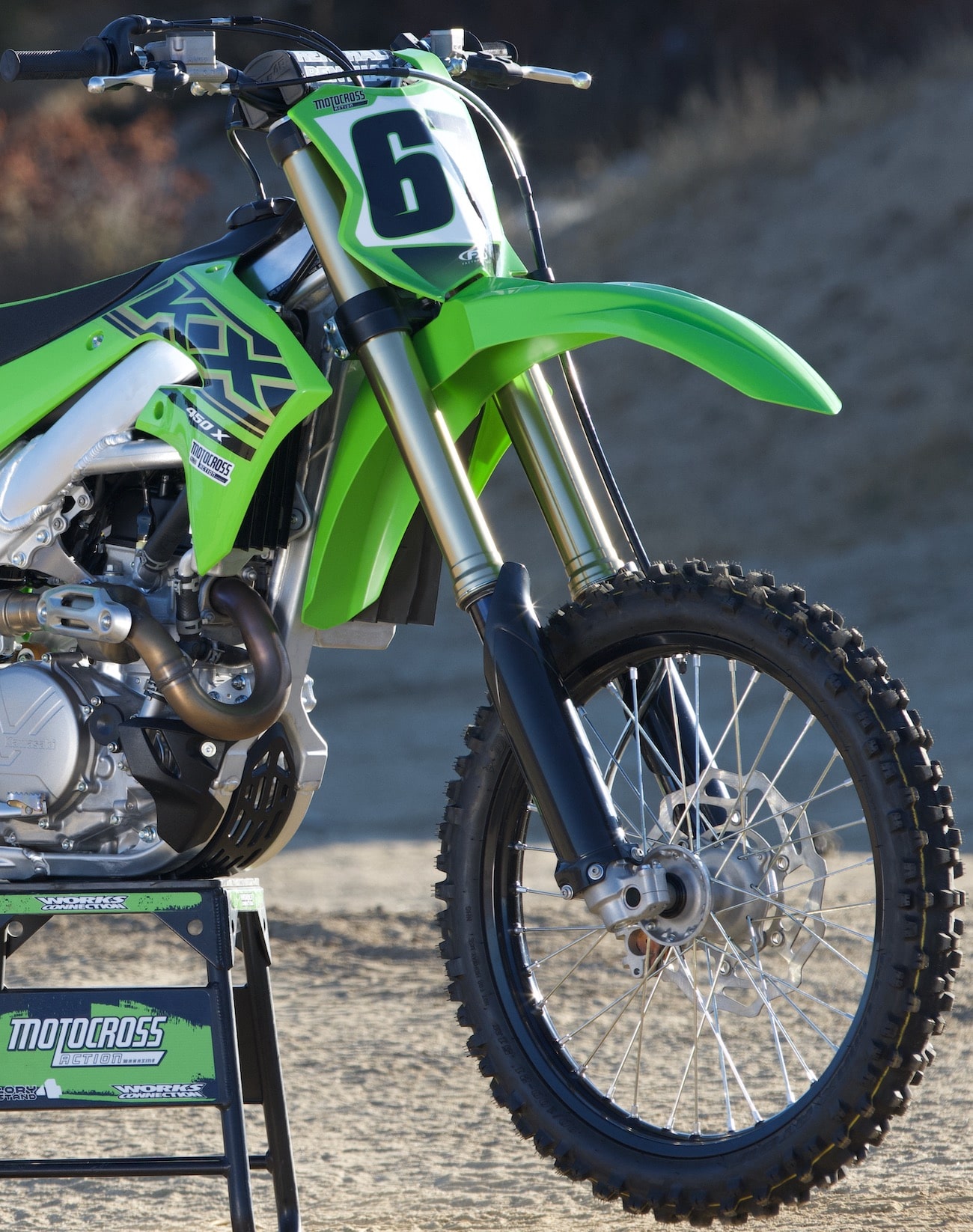

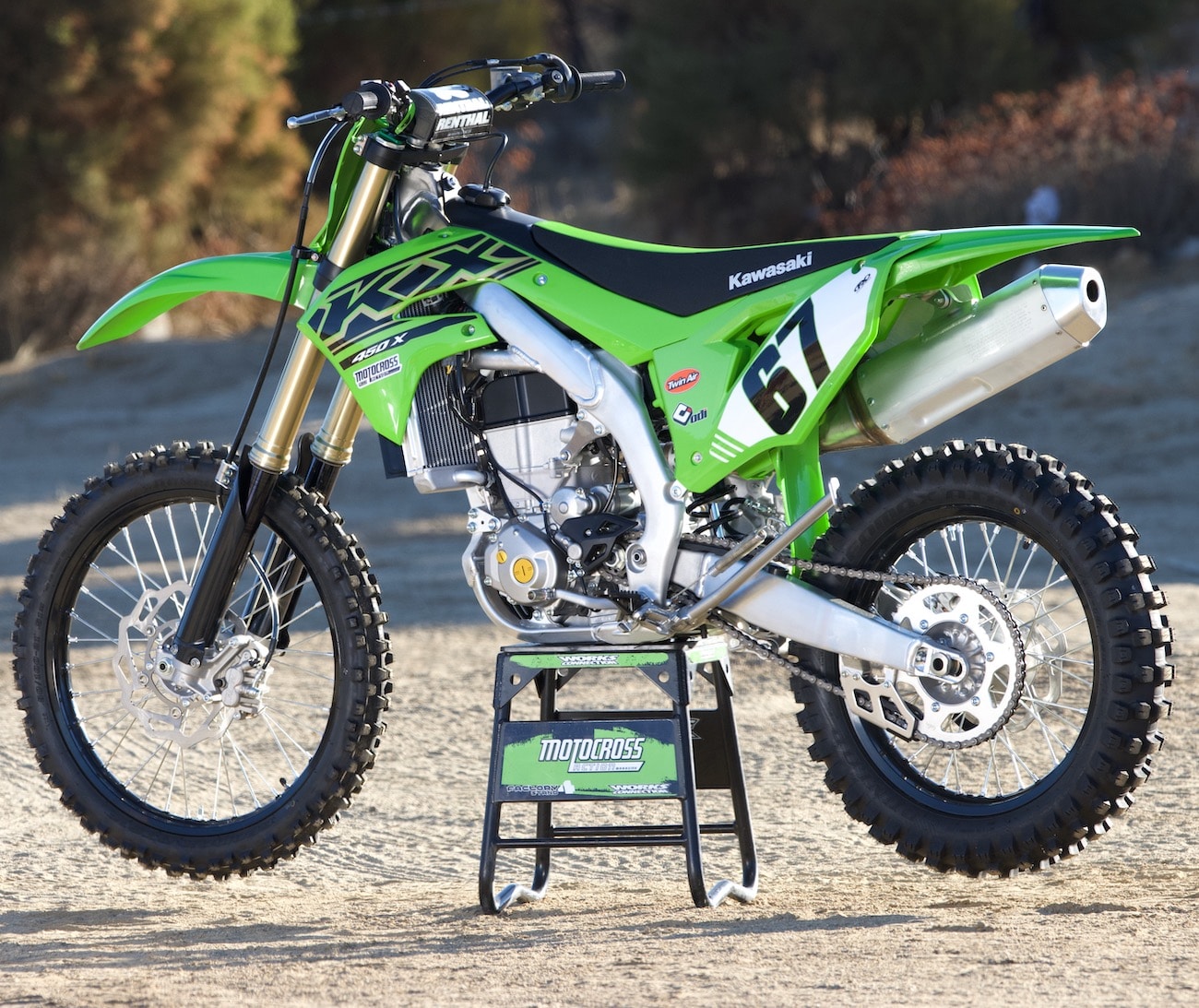


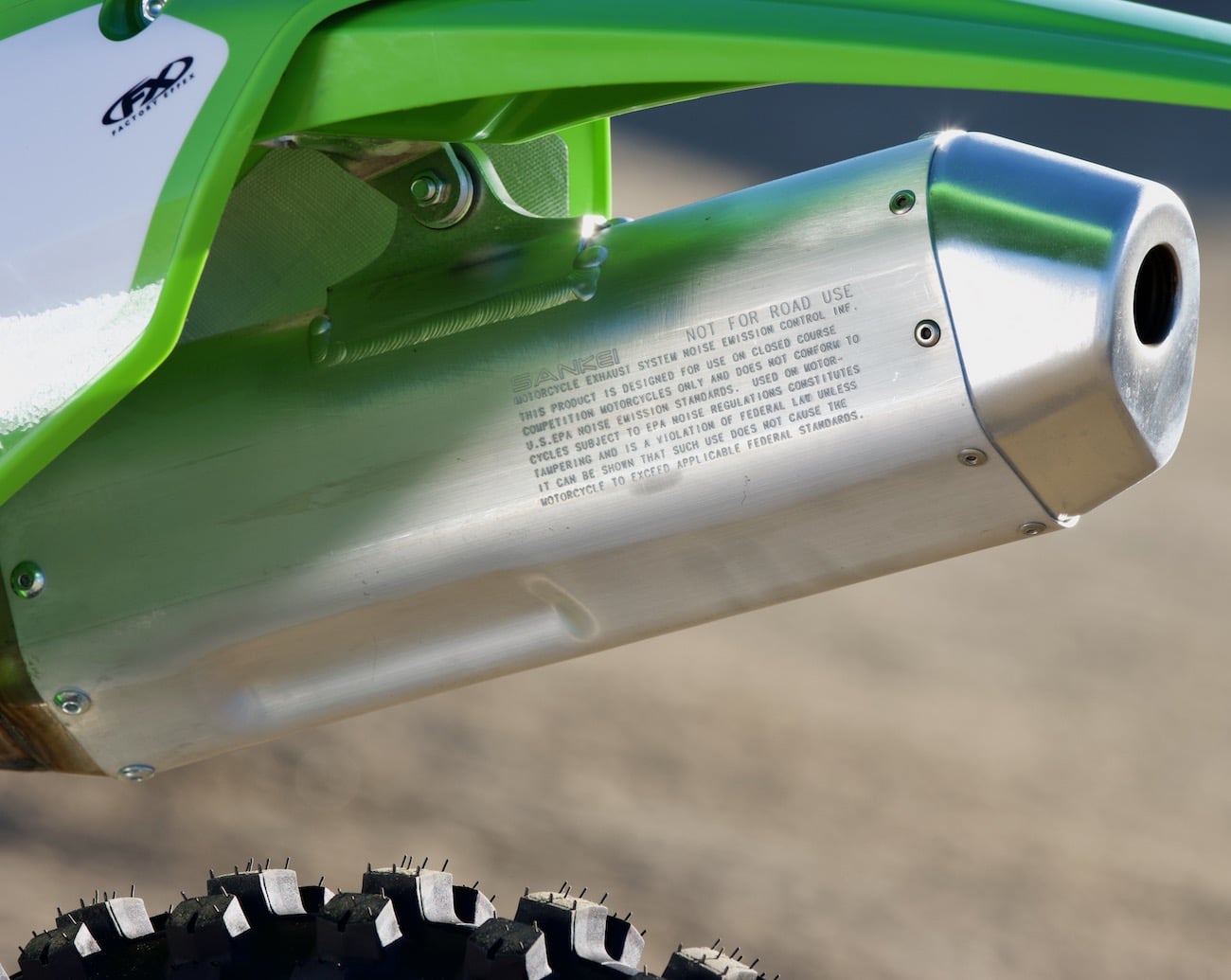
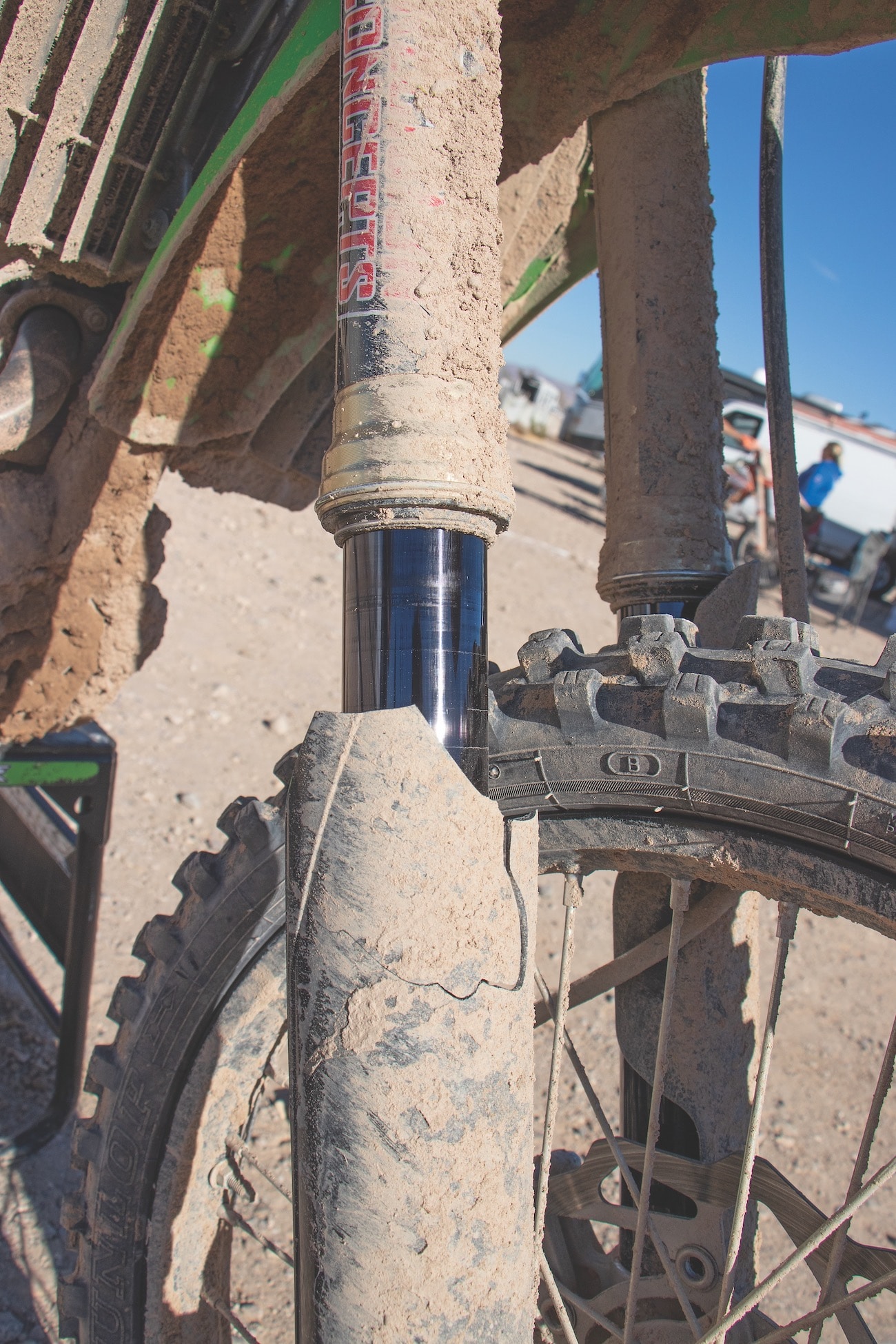
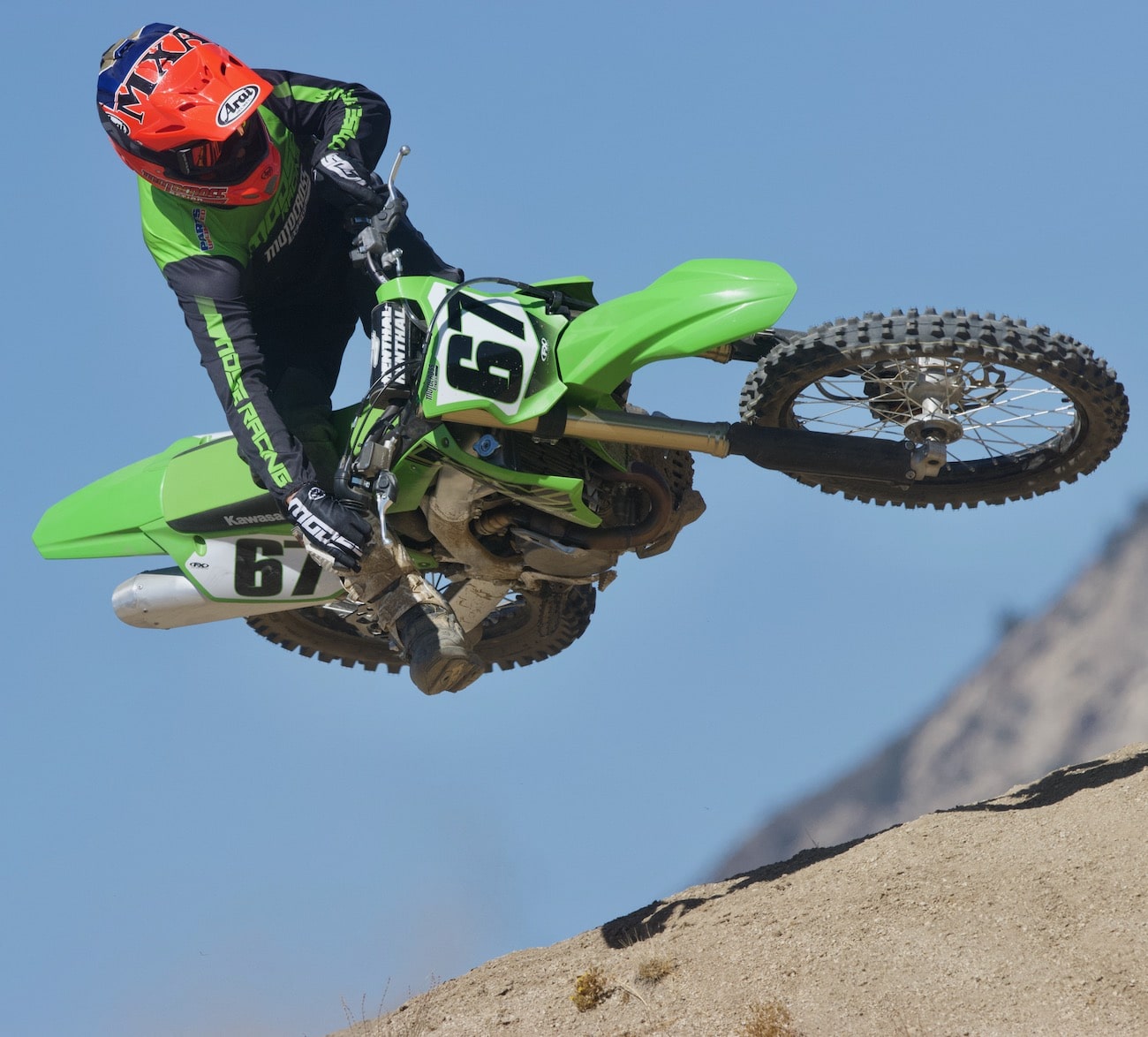
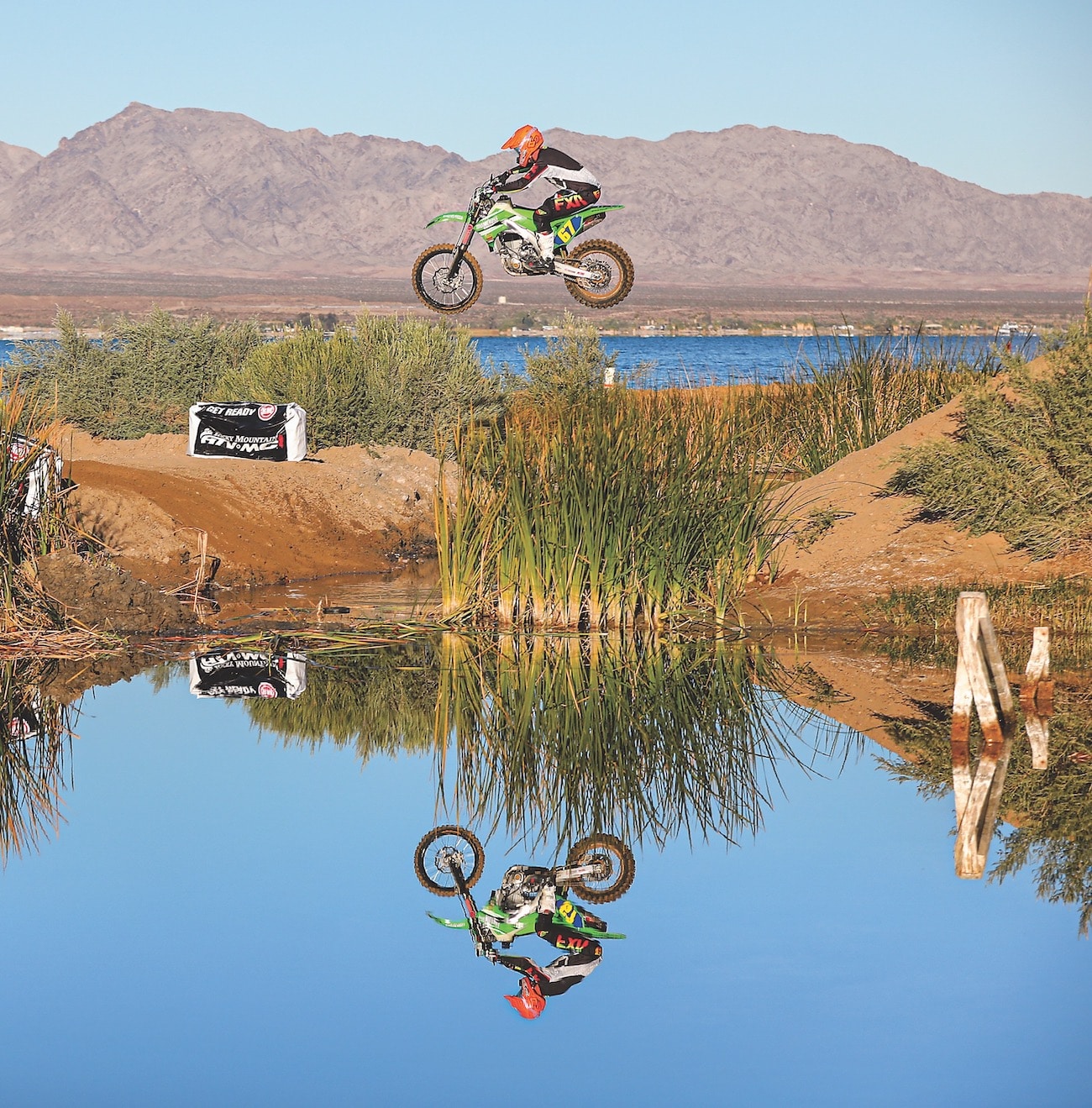


Comments are closed.